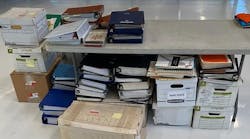Aircraft logbooks are one of the most misunderstood aspects of business aircraft operation. Why is that you ask? Well, for starters, looking through the Federal Aviation Regulations to determine what we should put into an aircraft logbook does not help us very much. For the professional aviation maintenance technician what a proper and well-documented logbook should look like are often both a mystery and the source of hours of frustration and wasted time trying to find important information in the aircraft’s record.
For the aircraft owner, this wasted time equates directly to money, time the aircraft spends on the ground instead of flying and even mean the safety of the aircraft itself. For aircraft owners and maintenance people alike, what’s in (or not in) an aircraft’s record will have major consequences when it comes time to having work accomplished on the aircraft or to comply with an inspection and/or a Return to Service.
Title 14 CFR was written, as most government regulations are, in such precise detail that it’s hard to understand, from a “big picture” viewpoint, what an aircraft logbook should look like and typically results in, to use a common catchphrase, “not being able to see the forest for the trees”.
This is unfortunate. Because an aircraft’s logbook is one of the most important assets an aircraft possesses. The logbook gives us a history of the aircraft and proof that the aircraft is Airworthy. Since an unairworthy aircraft is nothing more than a huge ramp weight with wings, it stands to reason that if the aircraft’s airworthiness cannot be proved, it becomes useless as a flying machine.
So, what exactly needs to be in a logbook to prove the aircraft’s airworthiness? That is a question aircraft maintenance technicians wrestle with every day. We find logbooks in every conceivable format, administered differently by every individual flight operation, and either lacking the data necessary to prove the aircraft’s airworthiness, or containing so much unnecessary data, that it becomes almost impossible to separate the “wheat” from the “chaff”.
Aircraft records can be simple; only containing the minimum amount of documentation to prove the aircraft’s airworthiness; or complex, having every bit of information that could one day be utilized by maintenance or operations to keep the aircraft flying. But no matter what style the logbook is, the objective should always be to have it organized so that someone / anyone can find the information necessary to prove the aircraft’s Airworthiness.
According to Title 14 CFR Parts 91.411, 413 and, 417 all aircraft records must contain the following information:
1. A record of the maintenance, modifications, and alterations accomplished to the aircraft.
2. The Total Time and Landings/Cycles on the aircraft and engines.
3. The current status of all Life Limited and Calendar Overall components installed.
4. The aircraft’s current Inspection Status.
5. A comprehensive list of Form 337’s applicable to the aircraft.
6. A list of ADs accomplished on the aircraft over its lifetime.
7. The status of FAR Part 91.411 and 91.413 Altimeter and Transponder checks.
This, of course, is just a quick overview of the requirements. In order to really prove that each one of these items is in-compliance; a deeper dive into the aircraft’s records is required. This is where the experienced maintenance technician comes in. It’s important to understand each aircraft model’s unique requirements and the critical areas that must be addressed with respect to each item.
As an aircraft maintenance professional, it’s your job to understand what is required to be included in an aircraft logbook, and how this information can be properly organized.
Knowing this information should come with the territory. It’s that simple.
Larry Hinebaugh is currently the executive director of a non-profit company called The Foundation for Business Aircraft Records Excellence. Hinebaugh was instrumental in creating this company after seeing so many aircraft operators inconvenienced, and aircraft owners financially harmed, by our industry’s poor logbook practices.





